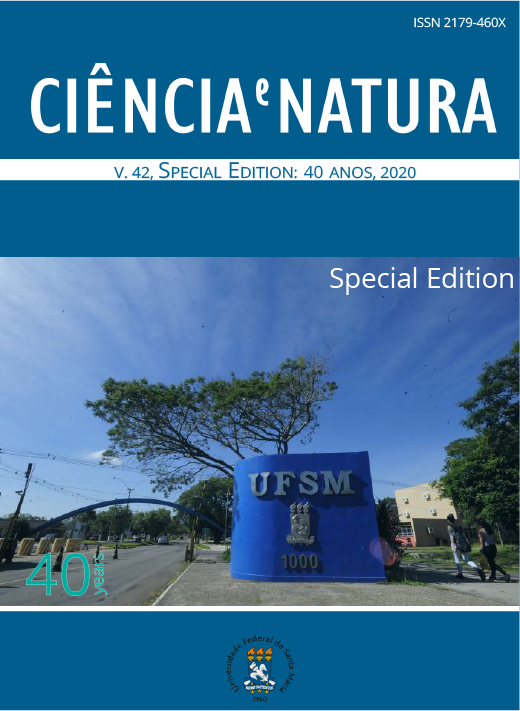The permian end catastrophe: an evidence for a broader phenomenon
DOI:
https://doi.org/10.5902/2179460X40986Keywords:
Permian extinction, Geo-physical-chemistry, Nuclear energyAbstract
It is well known that about 250 million years ago a huge catastrophe took place in our planet, with effects so big that about 95 % of the species disappeared in the process including sea animals. This event is called “the Permian extinction”. Other effects are also apparently connected to this event. This kind of event would require an extremely huge amount of energy. Since there is no evidence for an asteroid impact, the energy source should be searched inside the planet. Most importantly, it should show an energy source capable of producing such huge phenomenon. The aim of this paper is to propose a model to explain this extinction event and to show that there is evidence that this is a phenomenon that apparently happened several times not only in our planet but also in other Solar System bodies.
Downloads
References
BENTON MJ, TWICHETT RJ. How to kill (almost) all life: The end-Permian extinction event. Trends Ecol. Evol. 2003; 18; 358-365.
CLOUD P. Adventures in Earth History. 1st Ed. San Francisco: W. H. Freeman and Company; 1970.
CONEY L, REIMOLD U, HANCOX J, MADER D, KOEBERL C, MCDONALD I, STRUCK U, VAJDA V, KAMO S. Geochemical and mineralogical investigation of the Permian-Triassic boundary in the Continental Realm of the Southern Karoo Basin, South Africa. Palaeoworld, 2007; 16: 67-104.
GREENWOOD NN, EARNSHAW A. Chemistry of the Elements, 1st Ed. Oxford: Pergamon Press; 1984.
HERNDON JM. Planetary and protostellar nuclear fission: implications for planetary change, stellar ignition and dark matter. Proc. R. Soc. Lond. A. 1994; 445; 453-461.
HOLLENBACH DF, HERNDON JM. Deep-Earth reactor: Nuclear fission, helium, and the geomagnetic Field. Proceedings of the National Academy of Sciences. 2001; 98(20); 11085-11090.
MEIJERA RJ, ANISICHKINC VF, VAN WESTRENEND W. Forming the Moon from terrestrial silicate-rich material. Chemical Geology. 2013; 345; 40–49.
POPP JH. Geologia Geral. 6th Ed. Rio de Janeiro: LTC; 2012.
PRESS F, SIEVER R, GROTZINGER J, JORDAN TH. Para Entender a Terra. 4th Ed. Porto Alegre: Artmed Editora; 2007.
REUVER M, MEIJER RJ, TEN KATE IL, VAN WESTRENEN W. Boundary conditions for the formation of the Moon. Netherlands Journal of Geosciences. 2016; 95(2); 131-139.
SALGADO-LABOURIAU ML. História Ecológica da Terra. 2nd Ed. São Paulo: Edgard Blucher; 1994.
SAUNDERS A, REICHOW M. The Siberian Traps and the End-Permian mass extinction: a critical review. Chinese Science Bulletin. 2009; 54(1); 20-37.
SHEN S-Z, CROWLEY JL, WANG Y, BOWRING SA, ERWIN DH, SADLER PM et al. Calibrating the End-Permian Mass Extinction. Science. 2011; 334(6061); 1367-1372.
SIMONELLI G. The end-Permian extinction 2006; Available from: https://www.semanticscholar.org/paper/The-end-Permian-extinction-Simonelli/87d5826afb1a1dd324a7109ccea81440102a97af#paper-header
SMITH P. The Oklo phenomenon. Nature. 1974; 252; 349.
TEIXEIRA W, FAIRCHIELD TR, TOLEDO MCM, TAIOLI F. Decifrando a Terra. 2nd Ed. São Paulo: Companhia Editora Nacional; 2009.
Published
How to Cite
Issue
Section
License
To access the DECLARATION AND TRANSFER OF COPYRIGHT AUTHOR’S DECLARATION AND COPYRIGHT LICENSE click here.
Ethical Guidelines for Journal Publication
The Ciência e Natura journal is committed to ensuring ethics in publication and quality of articles.
Conformance to standards of ethical behavior is therefore expected of all parties involved: Authors, Editors, Reviewers, and the Publisher.
In particular,
Authors: Authors should present an objective discussion of the significance of research work as well as sufficient detail and references to permit others to replicate the experiments. Fraudulent or knowingly inaccurate statements constitute unethical behavior and are unacceptable. Review Articles should also be objective, comprehensive, and accurate accounts of the state of the art. The Authors should ensure that their work is entirely original works, and if the work and/or words of others have been used, this has been appropriately acknowledged. Plagiarism in all its forms constitutes unethical publishing behavior and is unacceptable. Submitting the same manuscript to more than one journal concurrently constitutes unethical publishing behavior and is unacceptable. Authors should not submit articles describing essentially the same research to more than one journal. The corresponding Author should ensure that there is a full consensus of all Co-authors in approving the final version of the paper and its submission for publication.
Editors: Editors should evaluate manuscripts exclusively on the basis of their academic merit. An Editor must not use unpublished information in the editor's own research without the express written consent of the Author. Editors should take reasonable responsive measures when ethical complaints have been presented concerning a submitted manuscript or published paper.
Reviewers: Any manuscripts received for review must be treated as confidential documents. Privileged information or ideas obtained through peer review must be kept confidential and not used for personal advantage. Reviewers should be conducted objectively, and observations should be formulated clearly with supporting arguments, so that Authors can use them for improving the paper. Any selected Reviewer who feels unqualified to review the research reported in a manuscript or knows that its prompt review will be impossible should notify the Editor and excuse himself from the review process. Reviewers should not consider manuscripts in which they have conflicts of interest resulting from competitive, collaborative, or other relationships or connections with any of the authors, companies, or institutions connected to the papers.







